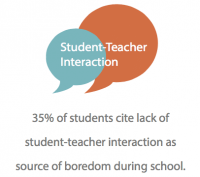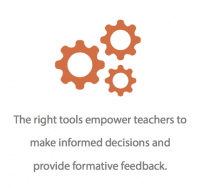3 Strategies To Integrate Technology, Increase Student Engagement, & Impact Overall Student Achievement
As school districts across the country invest heavily in technology, it is important to leverage research-based best practices. Many districts/schools are embarking on similar quests to integrate technology into classrooms and engage students, yet little collaboration takes place across districts/schools to share what works and what does not. One aspect of providing solutions to districts/schools is to investigate the current body of research and synthesize conclusions from past studies.
Engagement
Students who are engaged in school generally invest a substantial amount of time and effort to each task, care about their quality of work, and care about topics of future value. In an annual survey on student engagement conducted by the Center for Evaluation and Education Policy (CEEP) at Indiana University revealed that 66 percent of the students surveyed are bored on a daily basis in school, and 17 percent of students reported being bored in every class. Conversely, two percent of students reported never being bored in school. Students most frequently said the cause of their boredom was “material wasn’t interesting,” following by materials “lack relevance”. The 35 percent of students who were classified as bored reported the source of their boredom was lack of interaction with their teacher. “Projects and Lessons Involving Technology”. “Discussion and Debate”, and “Group Projects” were rated as the types of classwork that engaged students. By contrast, “Teacher Lecture” was rated the lowest with 26 percent. In instances with no teacher feedback (i.e., lecture), students are not engaged. Conversely, when students receive quality feedback, student engagement increases dramatically.
Feedback
 In a recent study on the effect feedback has on student performance and its future implications for learning, written comments and verbal feedback on assignments did not serve the purpose of aiding student learning or helping students to improve performance (Blair, Curtis, Goodwin, & Shields, 2013). Similarly, the researchers found that students were dissatisfied with quality, timeliness, and consistency in teacher feedback. The largest area requiring improvement was feedback from assessments. Less than 30% of students received verbal or written feedback on assessments (Blair, et al. 2013). As a result, students were found to have few opportunities to understand how they could improve or understand which specific skills and content they did not master.
In a recent study on the effect feedback has on student performance and its future implications for learning, written comments and verbal feedback on assignments did not serve the purpose of aiding student learning or helping students to improve performance (Blair, Curtis, Goodwin, & Shields, 2013). Similarly, the researchers found that students were dissatisfied with quality, timeliness, and consistency in teacher feedback. The largest area requiring improvement was feedback from assessments. Less than 30% of students received verbal or written feedback on assessments (Blair, et al. 2013). As a result, students were found to have few opportunities to understand how they could improve or understand which specific skills and content they did not master.
Technology Integration
Inan and Lowther (2010) found that teacher beliefs is the essential factor that determines effective implementation of technology in the classroom. Over 1382 teachers were studied, and findings were aligned with previous research suggesting personal beliefs and dispositions of teachers may relate to technology integration in the classroom (Ertmer 2005). The researchers also analyzed which factors influenced a teacher’s beliefs regarding technology integration. It was determined technology integration can be substantially influenced by provision of support, positive expectations, financial and physical resources, site and district administrative support, parental support, technical support, and professional development.
Online Curriculum
Classes that have online resources and personalized curriculum produce stronger student learning outcomes than do classes that solely provide face-to-face instruction (Harasim, 1995). However, students are limited to the resources available online due to high costs and the inability for online content to sync with the results of each student’s tests or assignments. For example, there are few assessment platforms that allow students to take tests online, give immediate feedback, and derive a list of resources targeting standards students did not master. The lack of ease has burdened educators with spending additional time gathering resources, distributing these resources to students appropriately, and monitoring learning.
What strategies should districts employ to impact overall student achievement?
- Provide tools for educators to aggregate student performance data. The tools should be within a platform where teachers have data to make informed decisions and provide formative feedback to students. The tools must include relevant results that are timely and deliverable to students, teachers, and administrators. The absence of feedback on exams is a major cause of students’ dissatisfaction with current assessment practices – hence low levels of student engagement.
- Students need online curricular resources that are directly tied to student strengths and areas for improvement to remedy deficiencies and deepen learning for content mastered.
2. Invest In Professional Development.
- Teachers and administrators need to feel confident and use technology in appropriate and relevant ways. Similarly, administrators, teachers and other staff members will need ongoing professional development specific to the purpose of integrating technology, while including conversations of problems that may emerge and how to overcome them. Educators must understand technology is a tool to provide quality and timely feedback to students to ensure continuous engagement in the teaching and learning process.
3. Give Timely Feedback to Students
- Ensure teachers give students feedback in a timely and comprehensive manner that includes assessments to ensure students are engaged and can take action.
We appreciate that each of these recommendations does not easily lend itself to implementation. One may be simpler and more straightforward than others, and cultural factors need to be considered before taking action. For example, educational leaders should clarify that feedback needs to be provided through a multitude of means, including assessments, written feedback on an essay, or through informal dialogue. It will be important to communicate expectations and outcomes that could include further professional development.
Download the the full white paper by filling this form.
Author: Abram Jimenez




I thought the comment about the teacher’s attitude was particularly useful. Thank you Ashl for sharing this.
The provision of technology support will go a long way in helping teachers and administrators have a positive attitude towards integrating technology. In working with all staff members in my district, I hear many say “I’m not techy” or “I don’t use computers.” It seems ironic that these statements are made by educated people that believe in helping students become life-long learners.
The real issue behind this is the lack of support. If the technology isn’t working right or if the user gets stuck, the need for a technician or help desk person to be available is critical to the success of integrating technology.
It is important to have a district/school plan in place to support teachers with both the tech (how to’s) and the application (why and what next next). This support must extend beyond the initial implementation phase in order for the technology to be utilized in the way it was intended.